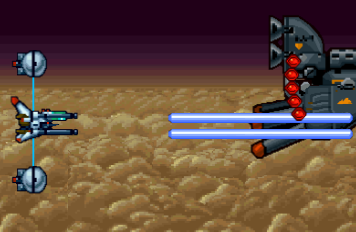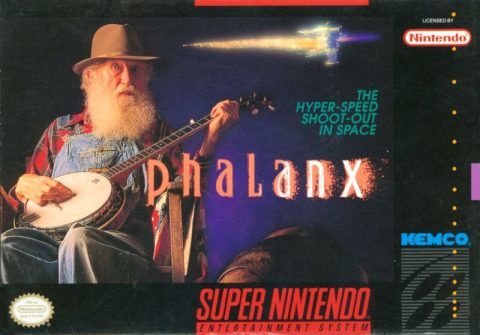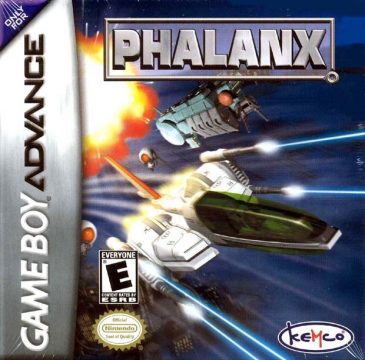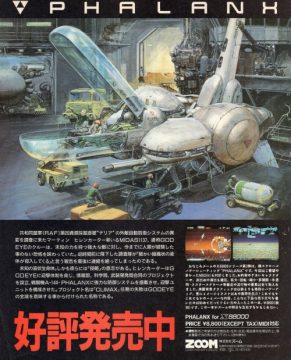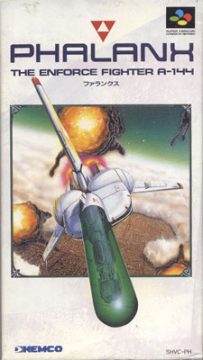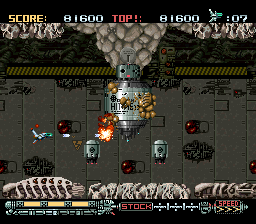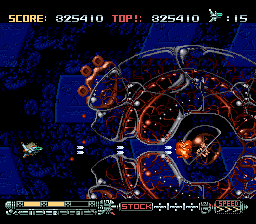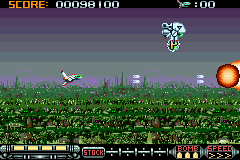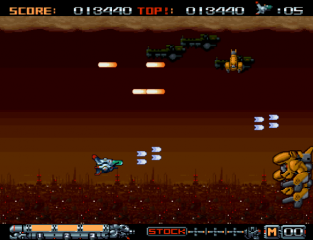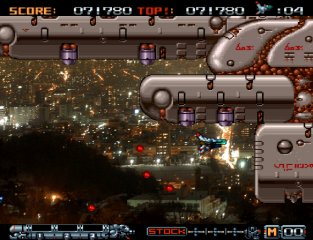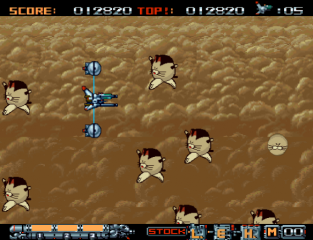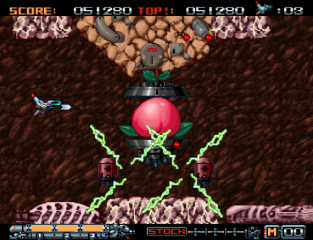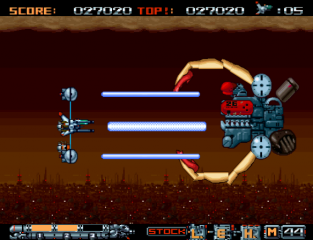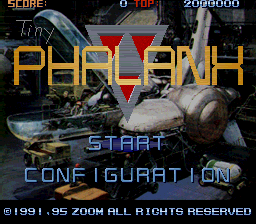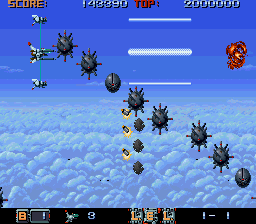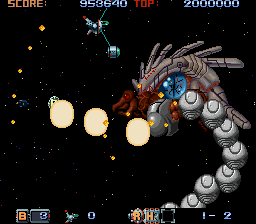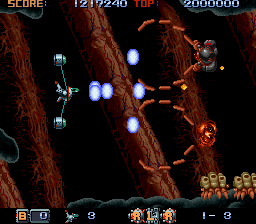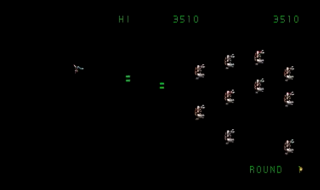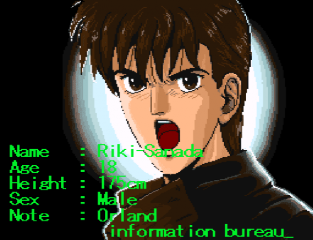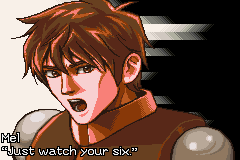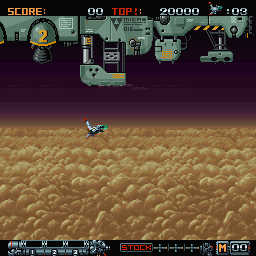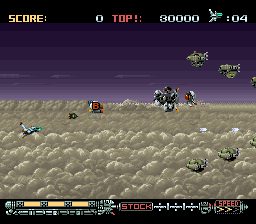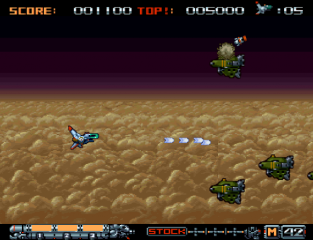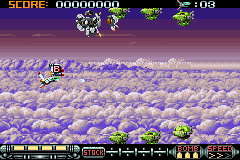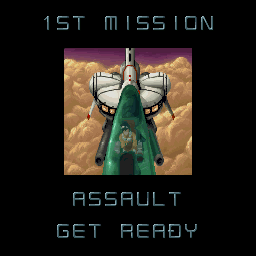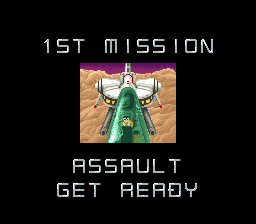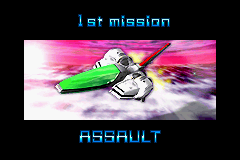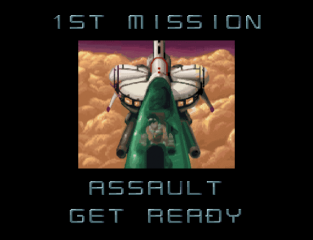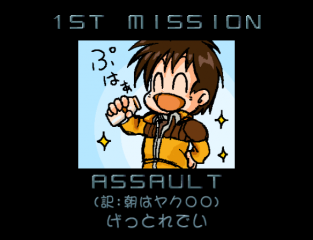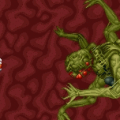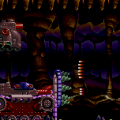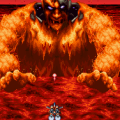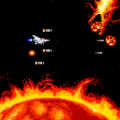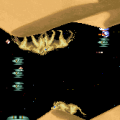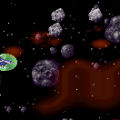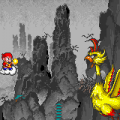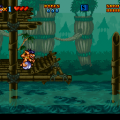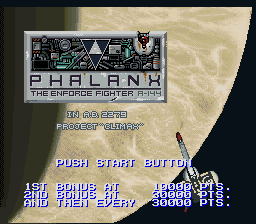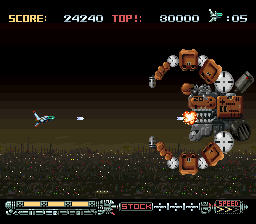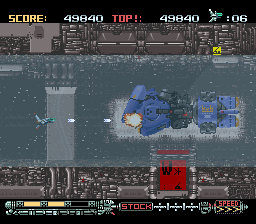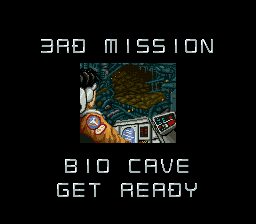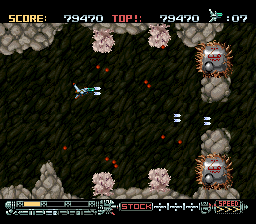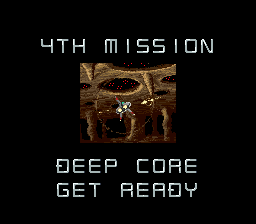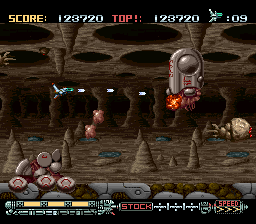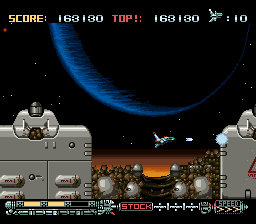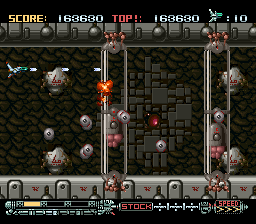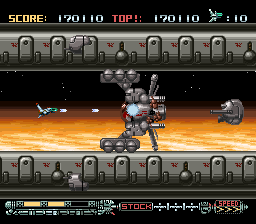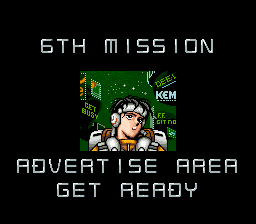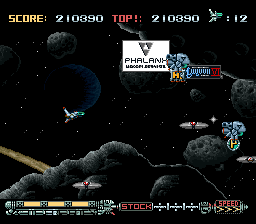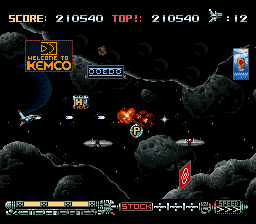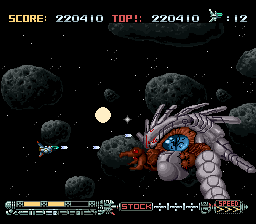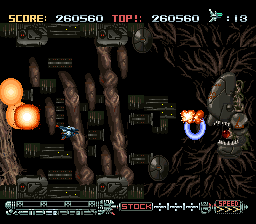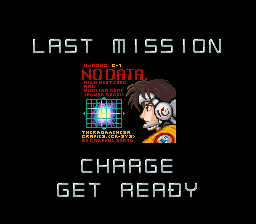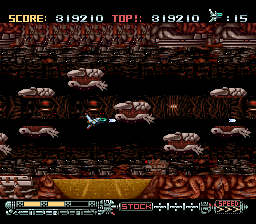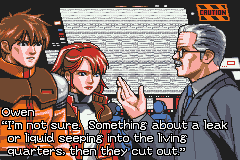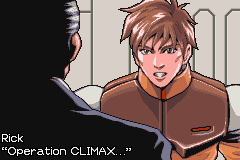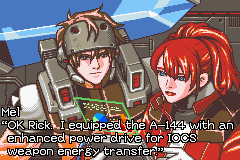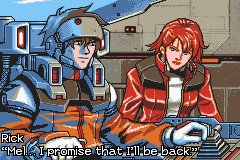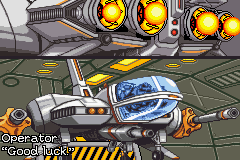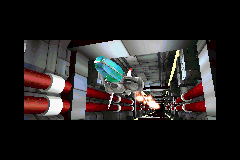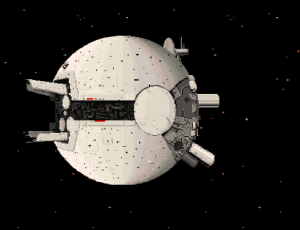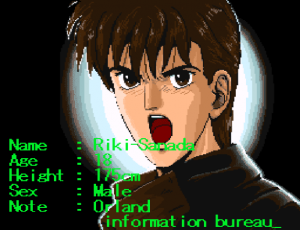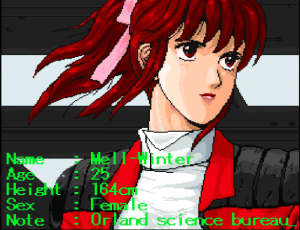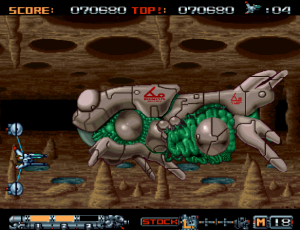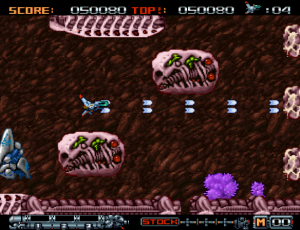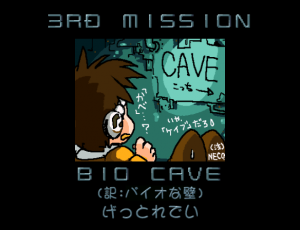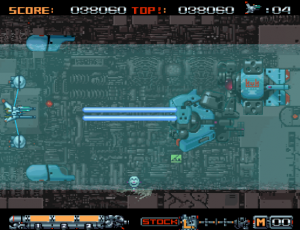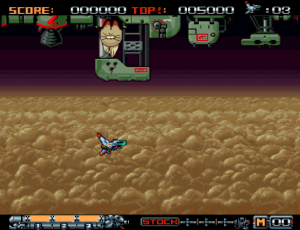Good old Phalanx, a very solid horizontal shooter that doesn’t do anything new, but also does everything well. It’s one of several X68000 games created by Zoom (and completely unrelated to the short-lived Amiga shooter series of the same name), who outside of the US are mostly known for the SNES version of a campy but rad Ys clone of theirs titled Lagoon. Like many computer platforms, the X68000 library is also plagued by a huge number of cheaply made shooters and questionable platformers. Phalanx may never be spoken of in the same breath as Gradius, but it’s a very smooth and colorful shooter that stands out on a platform with lots of imitators.
Taking place in the future year 2279, the story focuses on a human colony on the planet Delia, which has sent a distress call back to Earth to help fend off alien invaders. The hero, sent in the Phalanx space craft is named Wink Baufield, though it’s simply changed to Rick in the GBA version.
While a fairly standard shoot-em-up, Phalanx sets itself apart in few ways. It’s one of the few shoot-em-ups of the era where you have a life bar, so you can absorb several hits before losing a life. You can also store weapons and switch between them (at least in the SNES and later versions), or sacrifice one of them to use as a smart bomb, whose effect changes depending on the weapon being used as a source. There are four types of main weapons – Laser, Homing, Energizer, and Ricochet – as well as three types of missiles. It also offers a nice variety of weapons that are all useful and, in a move still unusual today for the genre, allows the player to keep and switch between several at once.
While many of the levels are fairly standard, it does have a few standout areas. Many shooters of the time had homages to the famous gigantic battleship level in Irem’s R-Type. This one has something similar, except the screen doesn’t scroll automatically, so you’re free to zoom around and attack the ship at any angle. The goal is to guide your ship inside of its tight corridors to a few interior segments, where you’ll fight a variety of bad guys. Beat all of these sections, and the ship goes down. There’s also an asteroid level called the “Advertise Area”, which features billboards for various other products.
With cool backgrounds and several fun weapons, the game’s only real faults are in its actual enemies. Most of the game’s foes are just plain uninspired, not well defined hunks of metal. While not every game will have enemy fighters are iconic as what’s found in the Gradius or Darius series, Zoom’s adherence to creating a more grounded set of military targets to blow away works against the generally colorful nature of the game. The exceptions comes near the end of the game, with some cool looking biological looking creatures, but even then, they aren’t as cool as the ones in R-Type.
While Phalanx was initially released for the X68000, its SNES port is far more well known. This was published by Kemco but developed by Zoom themselves, which makes it a fairly close port, but it does suffer a bit from the transition. The introduction scene has been drastically cut back, completely omitting the human characters, probably due to lack of ROM space. They still show up, but only in the cutscenes and at the ending. The color palette in some areas has changed a bit. The signs in the Advertise Area have also been altered to feature Kemco products rather than Zoom products. The one big improvement is that the X68000 version requires that you destroy a weapon before you use another one, while the SNES one lets you switch between them. You can also switch your ship speed during the game in the SNES, where in the X68000 one you had to set it at the beginning at the menu. Also, for some reason, the missiles had limited quantities in the X68000 version, where you can use them as much as you want in the SNES version. Overall, the SNES version is a little easier too.
However, the biggest difference between them is the totally different soundtracks. Phalanx may not be brought up often when favorites are being discussed amongst passionate fans of video game music, but the SNES version’s songs and sample selection will provide a burst of nostalgia to any fan due to its heavy use of that orchestral hit sample heard throughout the SNES’ early library. Neither soundtrack is particular outstanding, so it’s understandable why Zoom would attempt a do over, but after the SNES’ more driving first level song the rest of its music sounds particularly weak compared to both the original and to the tunes found in other SNES shooters of the early 90s. The X68000 version supports various sound modules but the pitch is a little off on some of the samples, so the onboard sound synth is the best. The soundtracks are also a bit of a letdown since Kenichi Kamio composed some great tracks for Valis II, and Super Chase H.Q., while S. Yamaguchi’s SNES soundtrack would be the last he ever worked on. Still, a relationship with Nintendo began here as many of the Zoom developers who ported Phalanx to the SNES also developed X-Zone for Nintendo that same year, and you can see that relationship continue as a few Zoom employees went on to work on installments in the Mario Party series.
However, the SNES port of Phalanx is famous among retro gaming fans for one thing: It’s unusual US cover art. There have been plenty of anecdotes about why an old man playing a banjo was chosen as the representative of a Japanese game set in the far future, but part of a September 2001 interview in Electronic Gaming Monthly still explains it the best:
Q: What was the deal with that old dude on the cover of the SNES shooter Phalanx?
A: Phalanx was just another Super NES sidescrolling shooter that we all probably would have forgotten by now – if not for the inexplicable shot of the bearded geezer strummin’ a banjo on the game’s box cover. Why the old guy? The problem is that all the game art looked alike at the time – monsters or spaceships or something,” explains Matt Guss, head of the advertising company behind the Phalanx campaign. “We wanted to create shock value so someone would have to pick the game up. We called it the ‘Heavy Huh?!’ factor.” Art director Keith Campbell says they did the photo shoot themselves, hiring a model for the role of the 80-something hayseed. “I’d used him before as Santa Claus on an album-cover shoot,” Guss adds. “I remember him coming into the studio, and I though the poor guy was gonna die right there on the stage. I think he’d had a stroke earlier – not earlier that day, but in the past . . . We stuck a banjo in his hands, and I think we stuck a spaceship behind his head that he was supposed to be staring at in wonder, sort of a Star Wars-come-to-the-Ozarks kind of thing.” You gotta admit Guss’ cover concept was mighty effective. After all, we’re still talking about the game 10 years after its release. Heavy, huh? If you’re too young to remember this game, don’t worry Kemco’s rereleasing it for the Game Boy Advance.
The cover certainly turned heads back in the day, but Phalanx failed to capture the hearts of SNES players, and critics were equally ambivalent. Nintendo Power gave the game what averages out to about a 70%, and Matt Bielby of Super Play Magazine was equally unimpressed, but also not able to readily fault the game either. Stating that “…one of the most middle-of-the-road of shoot-’em ups…while it’s far better than the worthless Blazeon and its pals, it equally trails well behind the likes of the brilliant Super Aleste.” Overall, Phalanx confidently maintains a slightly above average reputation compared to its competition.
Just over a decade later, several publishers produced conversions of various cult shooters like R-Type III: The Third Lightning, Steel Empire, and Darius for the Game Boy Advance. But the first of these to be released was actually a port of the SNES version of Phalanx courtesy of Kemco. The biggest addition is the reinstatement of the introduction, with redesigned, more modern looking characters. Not only is the intro back, but there are interlevel cutscenes that expand the story too, rather than just the single image that previously introduced each level. As far as the game itself, the backgrounds have been changed to brighter colors (and in some cases totally altered) to compensate for the Game Boy Advance of the time not having a backlight. Unfortunately the result when playing on any newer iteration of the hardware is garish. The soundtrack is based on the SNES version though the sound quality is very poor. It’s a bit easier than the other versions too, especially since limited-use screen clearing bombs have been added. Like many of these portable shooter ports, it suffers from the smaller screen, but overall, it’s not too bad, and it’s much better than R-Type III or Darius R.
Almost a decade after that, Zoom ported Phalanx to the Wii as a downloadable WiiWare title, just in time for the company’s twentieth anniversary. Rather than being a simple emulated version of the SNES game like a typical Virtual Console title, this is actually based on the X68000 version, with some changes and enhancements. Owing to the higher resolution, most of the sprites have been redrawn to feature more detail, though most of the game looks almost visually identical, though it’s missing some of the parallax scrolling layers in a few areas. The music is based on the X68000 version too, with slightly different sound synth. Like the SNES version, you can switch your weapons and speed on the fly, though missiles are still limited.
The biggest addition is a new arrange version, which features more comical graphics, including different pre-level pictures. Sometimes these changes are subtle, like adding the Zoom mascot, the cat Dolucky, to the ship hangar at the beginning of the game, but other times it’s more obvious, like turning the tendrils of a boss into long, female legs with high-heels at the end of them. Many of the enemies are also altered in rather silly ways, plus other changes are made, like the background in the battleship level being changed into an actual photograph of a city. It’s not exactly Parodius, but if you’re already familiar with the game, it’s worth playing through again just to see what was changed.
Phalanx wasn’t totally forgotten in the mid 90s. It made a surprise return as a short mini-game to help pass the loading time between fights in the early PlayStation 3D fighting game Zero Divide. This is activated by holding the Start and Select buttons on the second controller when booting up the game. Appropriately named Tiny Phalanx, it lets Zero Divide owners enjoy the first three levels of the game complete with a great new soundtrack.
It plays and looks much like the original game, and even the first level is similar, though it starts off during the day and then eventually transitions into dusk, instead of starting off at dusk. The missiles are gone, and it seems like the special weapon attacks weren’t implemented yet – when you switch between weapons, you lose them without any effect, as it seems like you just jettison them. Instead, you have limited used bombs, like the later GBA game. It’s actually a little together since there’s no shield anymore and you can only take a single hit. The visuals don’t take much advantage of the PlayStation’s capabilities, except for a polygonal rendered version of the ship, that flies out during the level-end screen and after you beat the game. The music is all new, and quite good too.
Considering this is a hidden bonus game, it’s surprisingly fully featured, complete with a score screen, and even a cheat code for invincibility. Beating a certain score will also unlock a character in Zero Divide too. Even if you have no interest in 3D fighting games, it’s worth checking out for Tiny Phalanx alone.
The third game in the series, Zero Divide: Final Conflict for the Saturn, features another hidden Phalanx minigame called MiniPhalanx, unlocked by playing the main game for more than three hours. However, it’s extremely simple compared to its PlayStation counterpart. There’s no backgrounds, music, or even sound effects, just simple sprites and enemies that spawn in constant waves until you stop.
The Zero Divide series was also important for Zoom. It was their first 3D game as well as their first PlayStation game, leading to Zoom also creating a Rurouni Kenshin fighting game as well as the PlayStation 2 cult game Mr. Mosquito (and its sequel).
Die hard X68000 fans, however, briefly had a much easier time playing Phalanx: In 2001 Zoom decided to freely distribute it along with the rest of their X68000 library on their official website! That iteration of the website is long gone, but as of the time of this article’s writing the files are still accessible via snapshots of their site on The Internet Archive, letting both newcomers and nostalgic fans check out games like Phalanx, Lagoon, and Genocide in a form closer to their original glory. But whether it’s on the X68000, SNES, or WiiWare, Phalanx makes for some great shooter comfort food.
Links:
http://www.zoom-inc.co.jp/wii/phalanx/index.html – Zoom’s Phalanx site
https://www.youtube.com/watch?v=QXfeXCjYGVk – Phalanx WiiWare footage
http://web.archive.org/web/20010523133900/http://www.zoom-inc.co.jp/2001/download1.htm – The earliest instance of Zoom’s old game download page
Screenshot Comparisons
Introduction
First Level
First Level Card
